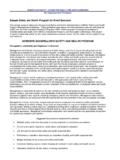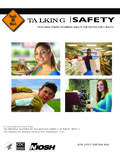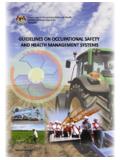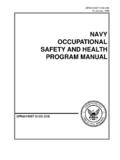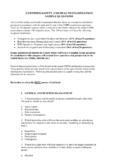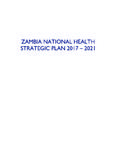Transcription of Interim Guidance for Protecting Workers from Occupational ...
1 FactSheetInterim Guidance for Protecting Workers from Occupational Exposure to Zika VirusThe Occupational safety and health administration (OSHA) and the National Institute for Occupational safety and health (NIOSH) are monitoring the Zika virus outbreak spreading through Central and South America, Mexico, and parts of the Caribbean, including territories. For the most up-to-date information, check the Centers for Disease Control and Prevention (CDC) Zika website frequently. Some states have mosquitoes that can become infected with and spread Zika virus, and travel-associated Zika virus infections in states may result in local spread of the virus. Visit the CDC Areas with Zika website to learn where there is current transmission. Workers who are exposed on the job to mosquitoes or the blood or other body fluids of infected individuals may be at risk for occupationally acquired Zika virus infection.
2 This Interim Guidance provides employers and Workers with information and Guidance on preventing Occupational exposure to the Zika virus. The Guidance may be updated as additional information becomes available. IntroductionZika virus is primarily spread through the bites of infected mosquitoes. Mosquitoes can become infected when they bite infected persons and can then spread the Zika virus to other persons they subsequently bite. Zika virus historically has been found in Africa, Southeast Asia, and the Pacific Islands. The first case was identified in the Zika Forest in Uganda in In 2015, cases of Zika virus infection emerged in the Americas and the Caribbean. Zika virus has the potential to spread anywhere that mosquitoes capable of spreading this virus are found. Aedes species mosquitoes are a principal vector ( , carrier) of Zika virus in the Aedes aegypti (commonly known as yellow fever mosquitoes) are typically concentrated in the southern as well as parts of the Southwest.
3 Another vector for Zika virus is Aedes albopictus (commonly known as Asian Tiger mosquitoes), which are found in much of the southern and eastern part of the Aedes mosquitoes can also carry other arboviruses, 1. Hayes, Edward B. Zika Virus Outside Africa, Emerging Infectious Diseases, 15, 9, 1347 1350 (2009). including dengue, yellow fever, chikungunya, Japanese encephalitis, and West Nile. CDC provides information about surveillance of Aedes mosquitoes in the Virus Infection in HumansCurrent science-based evidence suggests that approximately one out of five infected people develops symptoms of Zika virus, usually beginning 2-7 days after the bite of an infected mosquito. Symptoms are usually mild and can last 2 7 days. The most common symptoms of Aedes aegypti mosquitoes, like the one pictured, can become infected when they bite infected persons and can then spread the Zika virus to other persons they subsequently : CDC / James Gathany2 Zika virus infection are fever, rash, joint pain and red or pink eyes.
4 Other symptoms include myalgia (muscle pain) and headache. These symptoms are similar to those of dengue fever or chikungunya. Neurological and autoimmune complications are infrequent but have been described in outbreaks in Polynesia and, more recently, the first week of infection, Zika virus can be detected in the blood and is capable of being spread from an infected person to a mosquito that feeds on that person. Infected mosquitoes can then spread the virus to other people through bites. In some instances, having direct contact with infectious blood or other body fluids (such as semen through sexual transmission) of an infected person may result in transmission of the virus. Zika virus can be spread from a pregnant woman to her fetus and has been linked to a serious birth defect of the brain called microcephaly in babies of mothers who had Zika virus while pregnant.
5 Other problems have been detected among fetuses and infants infected with Zika virus before birth, such as absent or poorly developed brain structures, defects of the eye, hearing deficits, and impaired growth. CDC recommends special precautions for women who are or may become pregnant. Control and PreventionIn areas affected by Zika virus transmission, protect yourself and others from possible exposure to Zika virus by always taking steps to prevent mosquito bites. There is no vaccine to prevent Zika virus and there is no specific treatment for individuals who become infected. Although Zika virus is generally spread by the bites of infected mosquitoes, exposure to an infected person s blood or other body fluids (such as semen through sexual transmission) may also result in transmission. Employers should train Workers about their risks of exposure to Zika virus through mosquito bites and direct contact with infectious blood and other body fluids and how to protect themselves.
6 Employers should also provide information about Zika virus infection, including modes of transmission and possible links to birth defects, to Workers who are pregnant or may become pregnant or whose sexual partners are or may become pregnant. Outdoor Workers may be at the greatest risk of exposure to Zika virus. Some Workers , including those working with insecticides to control mosquitoes and healthcare Workers who may be exposed to contaminated blood or other potentially infectious materials from individuals infected with Zika virus, may require additional protections ( , certain types of personal protective equipment, PPE). Employers must comply with universal precautions for potential bloodborne pathogens (BBP) exposures, as described in OSHA s BBP standard (29 CFR ), and any applicable requirements in OSHA s PPE standards (29 CFR 1910 Subpart I), among other OSHA requirements.
7 Consult the CDC Zika website for the most up-to-date information to help employers implement effective worker protections. Outdoor Workers Recommended employer actions: Inform Workers about their risks of exposure to Zika virus through mosquito bites and train them how to protect themselves. Check the CDC Zika website to find Zika-affected areas. Provide insect repellents and encourage their use according to the Guidance below. Provide Workers with, and encourage them to wear, clothing that covers their hands, arms, legs, and other exposed skin. Consider providing Workers with hats with mosquito netting to protect the face and neck. In warm weather, encourage Workers to wear lightweight, loose-fitting clothing. This type of clothing protects Workers against the sun s harmful rays and provides a barrier to mosquitoes. Always provide Workers with adequate water, rest and shade, and monitor Workers for signs and symptoms of heat illness.
8 Get rid of sources of standing water ( , tires, buckets, cans, bottles, barrels) whenever possible to reduce or eliminate mosquito breeding areas. Train Workers about the importance of eliminating areas where mosquitos can breed at the worksite. If requested by a worker , consider reassigning anyone who indicates she is or may become pregnant, or who is male and has a sexual partner who is or may become pregnant, to indoor tasks to reduce their risk of mosquito worker actions: Use insect repellents according to the Guidance below. Wear clothing that covers hands, arms, legs, and other exposed skin. Wear hats with mosquito netting to protect the face and neck. Wear socks that cover the ankles and lower legs. In warm weather, wear lightweight, loose-fitting clothing. This type of clothing protects Workers against the sun s harmful rays and provides a barrier to mosquitoes.
9 Drink plenty of water, take rest breaks in shaded areas, and watch for signs and symptoms of heat illness, including in coworkers. Get rid of sources of standing water ( , tires, buckets, cans, bottles, barrels) whenever possible to reduce or eliminate mosquito breeding areas. Talk to your supervisor(s) about any outdoor work assignment(s) if you are or may become pregnant, or, for males, if your sexual partner is or may become pregnant. Such Workers should be familiar with CDC information on Zika virus and pregnancy. If symptoms develop, seek medical attention promptly. Discuss any possible exposure to mosquitoes or infections spread by mosquitoes with a healthcare on use of insect repellents for employers and Workers : Always follow label precautions when using insect repellent. Use insect repellent containing an EPA-registered active ingredient.
10 All of the EPA-registered active ingredients have demonstrated repellency, but some provide longer-lasting protection than others. Research suggests that repellents containing DEET (N,N-diethyl-m-toluamide) or picaridin (KBR 3023) typically provide longer-lasting protection than the other products, and oil of lemon eucalyptus (p-menthane-3,8-diol) provides longer-lasting protection than other plant-based repellents. Permethrin is another long-lasting repellent that is intended for application to clothing and gear, but not directly to skin. Choose a repellent that provides protection for the amount of time that you will be outdoors. In general, the more active ingredient (higher concentration) a repellent contains, the longer it will protect against mosquito bites. For example, the more DEET a repellent contains, the longer time it can protect you from mosquito bites, with protection times ranging from 1 hour ( DEET) to 5 hours ( DEET).










